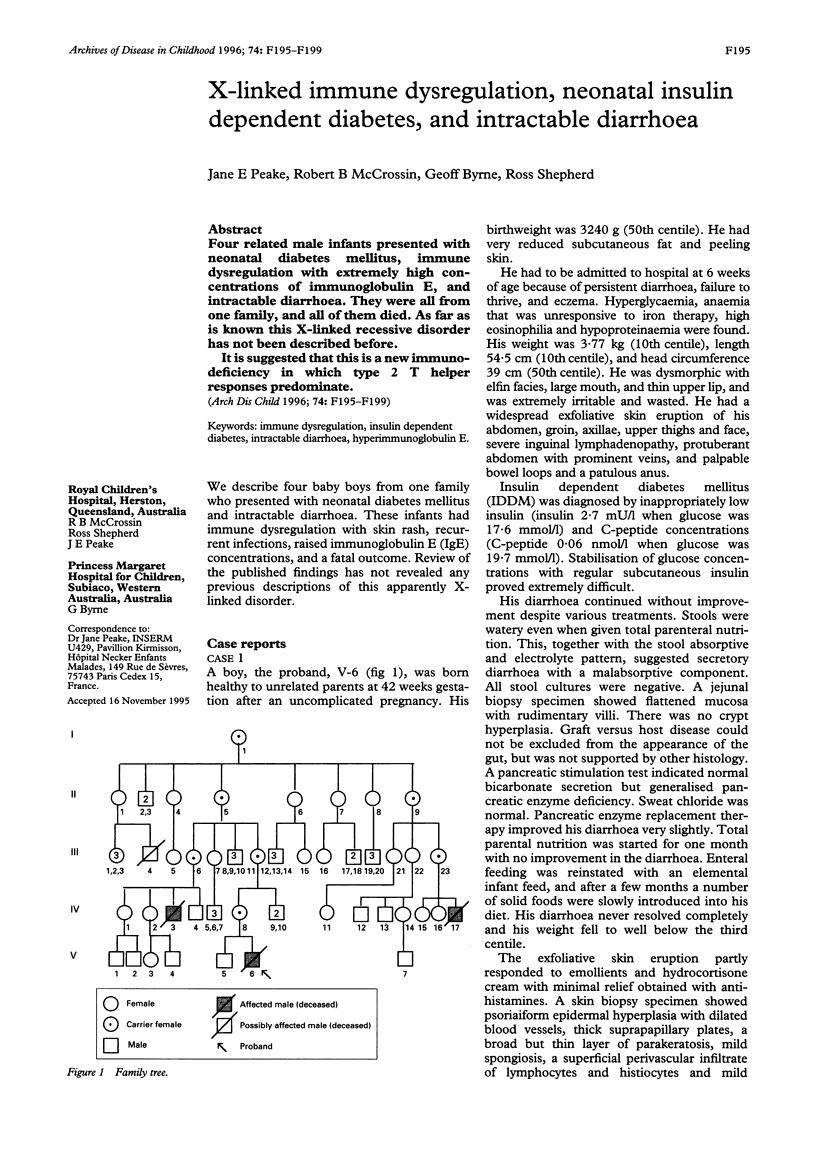Abstract
Four related male infants presented with neonatal diabetes mellitus, immune dysregulation with extremely high concentrations of immunoglobulin E, and intractable diarrhoea. They were all from one family, and all of them died. As far as is known this X-linked recessive disorder has not been described before. It is suggested that this is a new immunodeficiency in which type 2 T helper responses predominate.
Full text
PDF




Selected References
These references are in PubMed. This may not be the complete list of references from this article.
- ASSEVERO V. L., MOSS J. M. Diabetes mellitus in infancy; case report. J Pediatr. 1958 Aug;53(2):227–230. doi: 10.1016/s0022-3476(58)80176-6. [DOI] [PubMed] [Google Scholar]
- Candy D. C., Larcher V. F., Cameron D. J., Norman A. P., Tripp J. H., Milla P. J., Pincott J. R., Harries J. T. Lethal familial protracted diarrhoea. Arch Dis Child. 1981 Jan;56(1):15–23. doi: 10.1136/adc.56.1.15. [DOI] [PMC free article] [PubMed] [Google Scholar]
- Dodge J. A., Laurence K. M. Congenital absence of islets of Langerhans. Arch Dis Child. 1977 May;52(5):411–413. doi: 10.1136/adc.52.5.411. [DOI] [PMC free article] [PubMed] [Google Scholar]
- Dourov N., Buyl-Strouvens M. L. Agénésie du pancréas. Observation anatomo-clinique d'un cas de diabete sucré, avec stéatorrhée et hypotrophie, chez un nouveau-né. Arch Fr Pediatr. 1969 Jun-Jul;26(6):641–650. [PubMed] [Google Scholar]
- Fischer A. Primary T-cell immunodeficiencies. Curr Opin Immunol. 1993 Aug;5(4):569–578. doi: 10.1016/0952-7915(93)90040-y. [DOI] [PubMed] [Google Scholar]
- Geha R. S., Leung D. Y. Hyper immunoglobulin E syndrome. Immunodefic Rev. 1989;1(2):155–172. [PubMed] [Google Scholar]
- Hattevig G., Kjellman B., Fällström S. P. Congenital permanent diabetes mellitus and celiac disease. J Pediatr. 1982 Dec;101(6):955–957. doi: 10.1016/s0022-3476(82)80018-8. [DOI] [PubMed] [Google Scholar]
- Jonas M. M., Bell M. D., Eidson M. S., Koutouby R., Hensley G. T. Congenital diabetes mellitus and fatal secretory diarrhea in two infants. J Pediatr Gastroenterol Nutr. 1991 Nov;13(4):415–425. doi: 10.1097/00005176-199111000-00013. [DOI] [PubMed] [Google Scholar]
- Karol R. A., Eng J., Cooper J. B., Dennison D. K., Sawyer M. K., Lawrence E. C., Marcus D. M., Shearer W. T. Imbalances in subsets of T lymphocytes in an inbred pedigree with Omenn's syndrome. Clin Immunol Immunopathol. 1983 Jun;27(3):412–427. doi: 10.1016/0090-1229(83)90093-4. [DOI] [PubMed] [Google Scholar]
- Leung D. Y., Geha R. S. Clinical and immunologic aspects of the hyperimmunoglobulin E syndrome. Hematol Oncol Clin North Am. 1988 Mar;2(1):81–100. [PubMed] [Google Scholar]
- Meyer B., Nézelof C., Lemoine, Charlas J., Caille B., Vialatte J. A propos de deux cas de diabète néonatal. Ann Pediatr (Paris) 1970 Aug-Sep;17(8):569–573. [PubMed] [Google Scholar]
- OMENN G. S. FAMILIAL RETICULOENDOTHELIOSIS WITH EOSINOPHILIA. N Engl J Med. 1965 Aug 19;273:427–432. doi: 10.1056/NEJM196508192730806. [DOI] [PubMed] [Google Scholar]
- Powell B. R., Buist N. R., Stenzel P. An X-linked syndrome of diarrhea, polyendocrinopathy, and fatal infection in infancy. J Pediatr. 1982 May;100(5):731–737. doi: 10.1016/s0022-3476(82)80573-8. [DOI] [PubMed] [Google Scholar]
- Ring J., Landthaler M. Hyper-IgE syndromes. Curr Probl Dermatol. 1989;18:79–88. doi: 10.1159/000416841. [DOI] [PubMed] [Google Scholar]
- Romagnani S. Induction of TH1 and TH2 responses: a key role for the 'natural' immune response? Immunol Today. 1992 Oct;13(10):379–381. doi: 10.1016/0167-5699(92)90083-J. [DOI] [PubMed] [Google Scholar]
- Wong K. C., Tse K., Chan J. K. Congenital absence of insulin-secreting cells. Histopathology. 1988 May;12(5):541–545. doi: 10.1111/j.1365-2559.1988.tb01974.x. [DOI] [PubMed] [Google Scholar]


